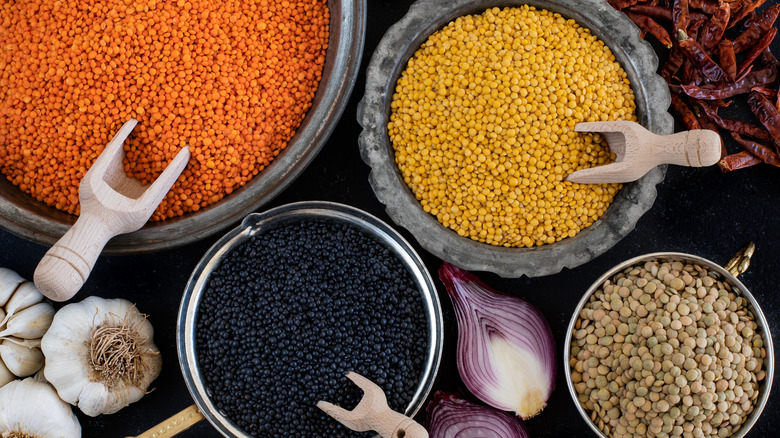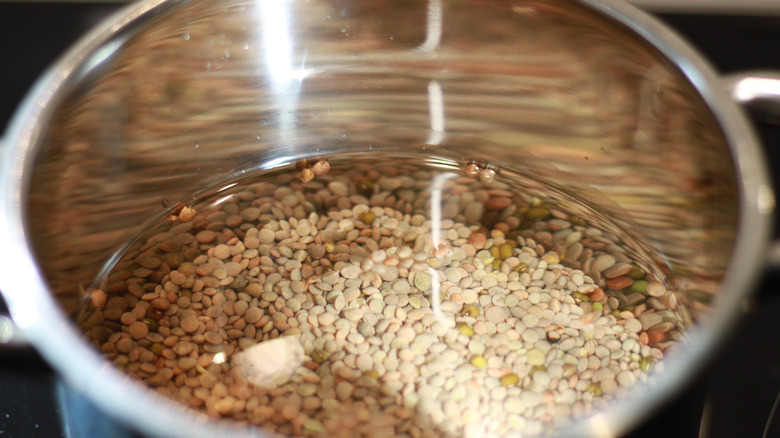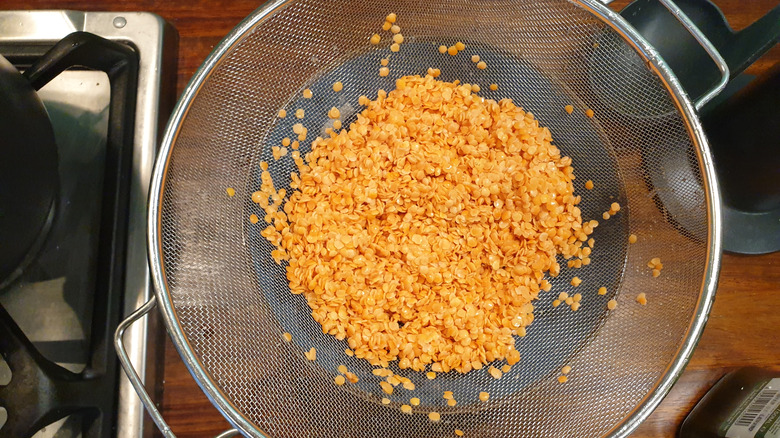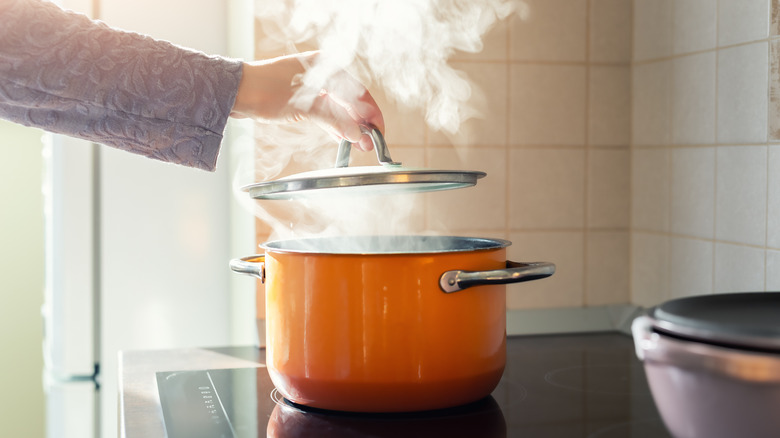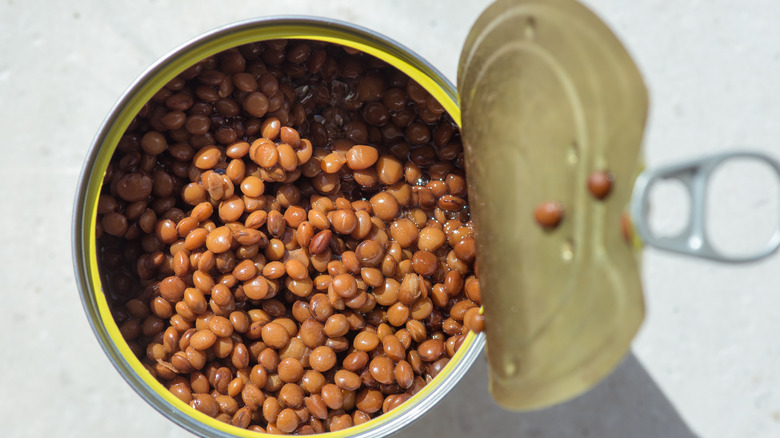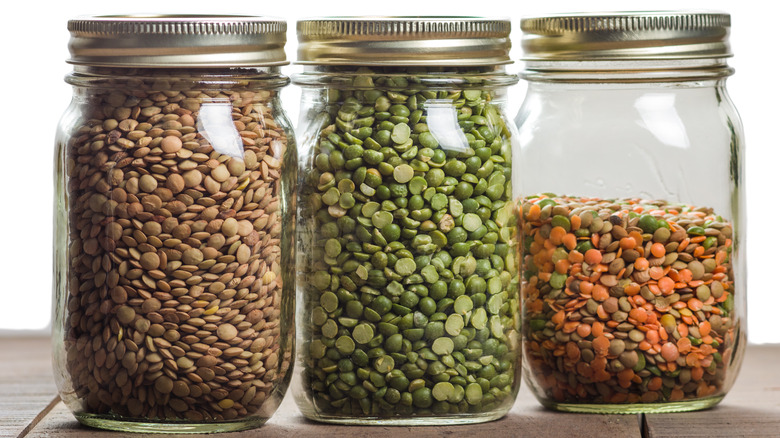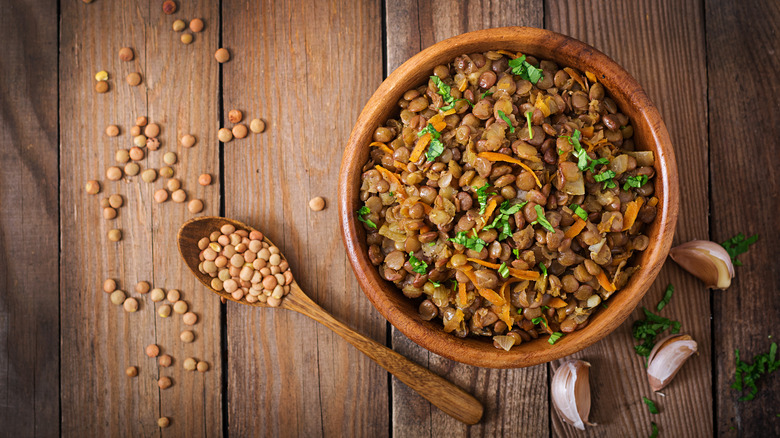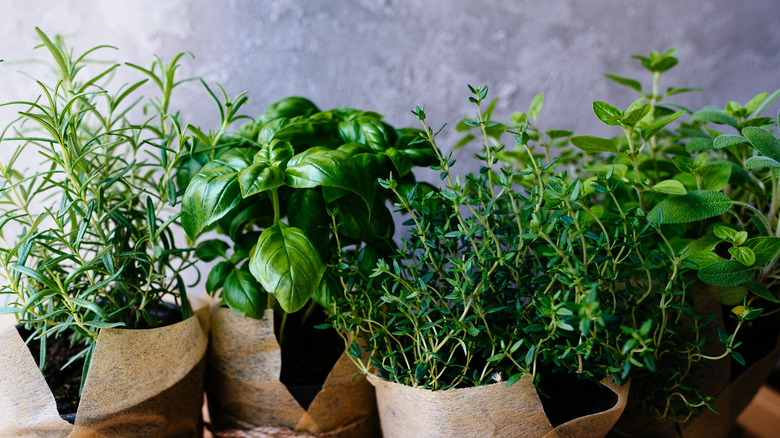Biggest Mistakes Everyone Makes With Lentils
According to WebMD, lentils are a staggeringly healthy food with a myriad of different nutrients like a high concentration of fiber, iron, folate, and potassium. These good-for-you legumes can be as delicious as they are nutritious if you know how to cook them properly. Unfortunately, it's all too easy to fall into common traps when cooking up these tiny powerhouses. Simple, understandable mistakes can seriously compromise the integrity of your dish and yield a mushy mess instead of a wholesome and tasty meal.
If your love affair with lentils has soured thanks to one too many dishes gone wrong, there is hope. These common rookie mistakes are easy to spot and change, and once you know what to do, cooking lentils the right way will become second nature. Then, you'll be well on your way to cooking up that beautiful bowl of hearty lentil soup or the perfect portion of dal in no time.
You're using the wrong lentil
All lentil varieties are not interchangeable, so choosing the proper type of lentil is absolutely vital for a successful dish. According to the Washington Post, green and brown lentils are more robust than their yellow and red cousins. Brown and green lentils take between 20 to 45 minutes to cook and work well for dishes where you need to keep the lentil's structural integrity intact, like salads or even chunkier lentil soups. In addition, they tend to be earthy and potent with rich flavor and crunchier texture.
If your dish calls for a more delicate pureed end product, look for split yellow or red lentils. Red lentils tend to be relatively mild and cook into a nice consistency in roughly half an hour. These lentils are ideal for creamier soups, Indian dal, or thick lentil dips. However, using red lentils in salads can result in a mushy dish.
You're not soaking your lentils
Lentils contain raffinose oligosaccharides, one of the major culprits that cause stomach problems and gas (via University of Saskatchewan). Fortunately, according to the India Times, there's a way that you can cut back on your belly trouble by simply soaking your lentils before cooking them. Not only does soaking your lentils reduce harmful oligosaccharides, but it also makes the other minerals and nutrients easier for your body to access.
To be on the safe side, soak your lentils in ample water overnight. You will cut way back on the nasties and prime your lentils for easy cooking the next day. Use cold or room temperature water and set your lentils aside in a safe place while the liquid does its magic. This super simple step only takes minutes and can save you a lot of literal discomfort, plus make your lentils much more nutritious and delicious.
You're not cooking them with aromatics and spices
Lentils need a little bit of love to really make them shine, which is why you should always cook with plenty of aromatics and spices. According to Taste of Home, aromatics are different herbs or vegetables designed to add nuance and taste to your dish. Basically, they work as a critical foundational element, weaving multiple flavors together and complementing the main ingredient.
Aromatics like onions and garlic work wonderfully with lentils, and sautéing them first lends a more potent and complex flavor base to your dish. This red lentil soup recipe illustrates how you can set up a framework of garlic and onions to build a simple yet sophisticated dish. Bay leaves are another phenomenal aromatic that lends a nice underlying flavor to your plate. Although these leaves are odorless and tasteless, they open up when simmered alongside other ingredients and are one of the cornerstones of successful cooking (via KRTV).
You're not sifting through your lentils
One of the cardinal sins cooks make when tackling lentils is not sifting them. According to NPR, your innocent-looking pile of lentils could be harboring a few tiny rocks. NPR advises that you spread out your lentils for a rapid scan, then run them through some water just to make sure you're not cooking or consuming anything inedible. Mashed points out that dirt and tiny pieces of debris might be lurking amongst your lentils, so the good old-fashioned sort and rinse is vital if you don't want to crack a tooth.
Once you know what to look for, this step takes a mere few minutes to run through. Although you might not find anything at all, you'll still have the peace of mind of knowing that you're not serving up dirt or rocks to people and that there are no lentil-related emergency dentist bills in your future.
You're not using enough water
If you want to wind up with perfectly cooked lentils, you need to give them plenty of water to do their thing. According to the BBC, lentils need a whole lot of water to cook all of the way through. So use at least three times more water than lentils and avoid the temptation to salt the water. Adding salt can make the lentil's exterior tough and unappetizing (via Lentils.org). Instead, pop them in your waterlogged pot and throw in a bay leaf or two to enhance the flavor.
The BBC also notes that you shouldn't add vinegar or lemon juice to your cooking water, but Lentils.org says that adding it afterward is definitely ok. Vinegar can make the flavor of lentils pop; counterbalancing some of that deep, earthy nuttiness with a beautiful burst of bright acid. Add carefully, and to taste, once your lentils are fully cooked and ready for the next steps.
You're ignoring canned lentils
Canned lentils are a phenomenal shortcut ingredient that even the best cooks often overlook. They can save you multiple steps, bulk up dishes in a hurry, and add a powerful boost of nutrients and fiber to your weeknight or quick and healthy meals. However, when using canned lentils, there are a few things that you should keep in mind, specifically rinsing them before use. Canned beans and lentils are preserved in a thick solution that's way heavy on the starch and salt, and it can totally throw off the flavor profile of your dish.
Once you've given your canned lentils a quick rinse, you're good to go. According to the Healthy Food Guide, canned lentils are endlessly versatile and convenient, lending themselves perfectly to creamy lentil soups, stews, dips, and other dishes where you need some heft. You can even sprinkle them onto your salad for extra fiber and taste.
You're not cooking your lentils in batches
Using canned lentils is one shortcut way to add a hearty and healthy dose of the good stuff to any recipe, but another excellent trick that lentil enthusiasts know and love is batching. Cooking your lentils in batches saves tons of time and effort. These tiny superfoods will maintain their taste and structure for many months in the freezer or an entire week in the refrigerator (via Unlock Food).
If you're worried about your lentils getting squished in the freezer, Livestrong offers an intelligent solution. They suggest that you put thin layers of lentils onto baking sheets and pop them into the freezer for a few hours. This way, your lentils will freeze, harden, and stay intact when you put them into carefully labeled and airtight freezer bags. Batch-cooking your lentils for future consumption is a timesaving hack that allows you to have home-cooked veggies anytime.
You're not cooking your lentils all the way through
Cooked lentils are a powerhouse food crammed with nutrients and fiber, but uncooked lentils are a totally different story. According to Mashed, lectin lurks in these raw legumes. Lectin wreaks havoc on your stomach, and extreme cases can cause major bathroom issues. So to avoid giving yourself a mild lectin-induced bit of food poisoning, make sure that you cook those suckers all of the way through.
According to Medicine Net, lentil's lectin is actually a defense mechanism, shielding wild lentils from would-be predators, and it might not just cause stomach cramps and some discomfort. Over time, lectin build-up might impact your health in very negative way, impacting how many minerals and vitamins your body will accept and even leading to new allergies or ongoing illnesses. It's best to outsmart the tricky plant and cook your lentils until a tender doneness.
You're not thinking outside the lentil soup box
Lentil soup is incredible; it's like a warm, veggie-rich hug on a cold afternoon. Every good cook should have at least one solid lentil soup in their repertoire, but it's important not to limit your possibilities by staying firmly in the lentil soup box. Lentils are amazingly adaptable and complement nearly everything from dips to salads. This recipe is one stellar example of how lentils can elevate a humble pasta dish.
According to the Smithsonian, lentils can even play nicely with desserts if you pair them with dried fruit and some whole oats. You can also thicken up a pie with lentils, masking their taste with juicy apples and a hint of vanilla. But, if desserts are a bridge too far for you, never fear. Lentils are incredible in casseroles, salads, or as a smart swap for chicken, beef, or pork on meatless Mondays.
You're not adding fresh herbs
Fresh herbs add color, freshness, and taste to any lentil dish. They're also the logical herbaceous yang to lentils' earthy yin and are full of fantastic health-boosting antioxidants (via Better Health). Although fresh herbs are almost always preferable, thanks to their higher antioxidant content, you can swap in dried herbs in a pinch (via Mashed). Since dry herbs tend to have concentrated flavor, you'll definitely want to measure them out rather than liberally sprinkling them onto the top of your dish and hoping for the best.
In addition to their wicked strong range of powerful antioxidants, herbs are also aromatics, infusing your lentils with complex layers of flavor and adding a nice bit of brightness at the end. Parsley and chopped basil are both excellent, standard bets, but you can always go with more out-of-the-box players like cilantro or rosemary (via Livestrong).

